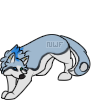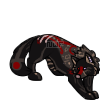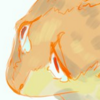Raviolli wrote:GrumpyCinnamonster wrote:DemzeeDemon wrote:I have a 15 year old female leopard gecko named Gwin. I received her from a family friend who could no longer take care of her and I have only had her since late December. Since being with us she seems to be happy and healthy. However when I came home today I was sort of shocked to find that she had dug a whole in her sand (crushed walnut) and laid two eggs. Since then she has buried both of them with a mound of sand that she has pushed from all over her tank and is now "guarding" them. I realize that these are more than likely "dud" eggs, similar to bird behavior. I am just not sure how to handle this. Do I need to remove these eggs? And how do I avoid upsetting her? Advise would be appreciated. =3
I would first recommend getting rid of the crushed walnut. It can easily lead to impaction, which can kill your lizard. The safest substrate for leos is reptile carpet, tile, or paper towels. If feel you must have a loose substrate, then get plain play sand, and wash it before putting it in the cage. However, sand, like crushed walnut shells also has a risk of causing impaction.
As for the eggs, I suggest removing them immediately. They are infertile, and if left in the tank will rot, which could cause bacteria to start growing. She is most likely just defensive, because laying eggs can be stressful. She will be perfectly fine if you remove them.
I have to correct you on the impaction on this one. It does not "easily lead" to impaction, chances of it happening is a small chance with older reptiles. I am not saying there isn't that chance but if it was a large problem and a reptile in the wild had a likely chance of it happening why do we still have so many? You simply need to watch the behavior of your reptile and if you notice any changes you give in a warm bath once a day until they are pooping regular again.
As for the eggs. I am surprised she is guarding them normally they just sit on the eggs for a little bit before forgetting about them and moving on. Easiest way is to carefully take her out and place her in a holding container of some sort and just remove them or if she is giving you trouble just take something to carefully move her away. Keep an eye on her after you remove them because Leopards often lay more eggs a few weeks after and may do this for a month (4 to 6 eggs all together), I don't know if she will since they are duds but its always good to keep an eye on her. Also make sure she eats a lot. Egg laying (or birth in general) can be hard on females so high protein foods like, Butterworms Waxworms or if you really want to spoil her Silkworms, if she doesn't like worms than just make sure to gut load your crickets a little more than normal so that if she has lost any weight that she will gain it back.
You are more than welcome to disagree, but I still stand behind what I said. I've done 4 dissections on lizard with impaction caused by both sand(1 specimen) and crushed walnut shell(3 specimens), and I've also watched a dissection on a skink that perforated it's stomach from swallowing bark. From my experiences crushed walnut shell is one of the worst loose substrates, and it surprises me they still sell it in pet stores, but then again they also still sell things like calci-sand, which might as well be labeled as cement. Not only does walnut shell clog the digestive tract, it's a very sharp substrate that can cut the insides, which can lead to inflammation and infection. Loose substrates, particularly walnut shell, are also prone to growing bacteria and fungus(from the feces, urates, and any moisture) which can make your reptile ill. If someone wants to keep a reptile on loose substrate, then the best choice is to find something as close to their natural habitats as possible. I don't know of anything that lives on crushed walnut shells. Above all, if it's not necessary for the health of your lizard, and actually poses a risk to make your lizard sick, then why put it in the enclosure? I do not personally like loose substrates, unless they are required(such as for burrowing species) or at least mimic the natural substrate the species would be found on. I prefer solid substrates, which are generally cheaper and more sanitary, but if someone wants a loose substrates, and will not consider a solid one, then there are safer options than crushed walnut shell.
Young reptiles are typically at a higher risk of developing impaction, because they are sloppy eaters and because their digestive tracts are still small(particles have a harder time passing). Unlike larger lizards, such as beard dragons or uros, leos, leos pretty much never lower the risk of impaction on crushed walnuts shells due to the size of their digestive tract always remaining fairly small.
Impaction is also something caught too late by many owners of reptiles. Too few actually take their reptiles to be routinely examined by a vet, who may be able to catch it early on, but even among the ones that do take their reptiles to be examined may still be to late to correct the damage, especially on a lizard as small as a leo. The surgery to correct an impaction would most likely kill a leo, or at least be exceptionally risky if you could find a vet willing to do it.
Once again, you are more than welcome to still disagree, and keep your reptiles on whatever you want, but I've personally seen the damage of loose substrates, and will continue to encourage others to avoid them if it's just an option for their species. I do not like to take unnecessary risks with my reptiles, especially when the only thing I get out of using a loose substrate is a more "natural" looking enclosure.
For anyone that would like a complete list of substrates and why they are/are not suitable, then please read these two links.
http://www.anapsid.org/substrates2.htmlhttp://www.anapsid.org/substrates.html













